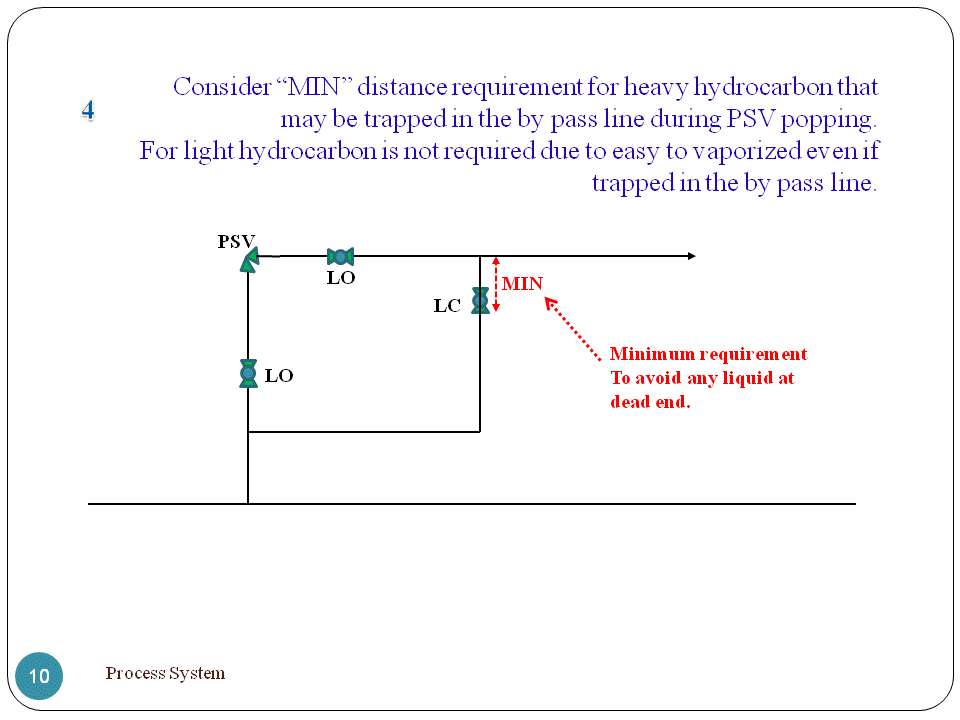PSV Installation-Guide
My friend, Let me share a simple material about PSV installation. However it will only focus on designing the system. This is become my first posting in this year. Hopefully, this material is useful for you in developing the system around PSV.
My friends, in developing or reviewing the P&ID, especially in PSV system, please consider the following ;
1. PSV normally be installed close to protected equipment.
The safety valve is installed for protecting the equipment, so that the closer to the equipment is better. For example, from safety point of view, to install the PSV directly at vessel is better than at line outlet vapor.
2. PSV for vapor application at vessel -shall be connected to the vessel in the vapor space higher than HHLL.
3. If any demister, PSV shall be connected to the vessel at below the demister since there is any potential blockage of demister, and if the PSV be installed at downstream demister, it will not protect the vessel in that case.
4. PSV may be installed at outlet vapor line. For this case, take care with the 3% pressure drop limitation.
Thank so much for support me guys, I love you.
I hope this weekend give you all the best of everything,
My friends, in developing or reviewing the P&ID, especially in PSV system, please consider the following ;
1. PSV normally be installed close to protected equipment.
The safety valve is installed for protecting the equipment, so that the closer to the equipment is better. For example, from safety point of view, to install the PSV directly at vessel is better than at line outlet vapor.
2. PSV for vapor application at vessel -shall be connected to the vessel in the vapor space higher than HHLL.
3. If any demister, PSV shall be connected to the vessel at below the demister since there is any potential blockage of demister, and if the PSV be installed at downstream demister, it will not protect the vessel in that case.
4. PSV may be installed at outlet vapor line. For this case, take care with the 3% pressure drop limitation.
5. For inlet line, please consider the total pressure drop of inlet line less than 3% of set pressure of the PSV.
This requirement (3%) is to avoid chattering on PSV.
6. Inlet PSV shall "free draining" to avoid liquid accumulation.
Please consider put NOTE on the P&ID, and as process engineer, you should check the final design by Piping engineer.
7. Block valve at inlet line ( if any) shall be LO and LC for spare PSV.
Block valve at outlet line (if any ) shall be LO
8. if discharged to ATM ( please indicate on P&ID "ASL" (at safe location) instead of ATM). The block valve is not required. The weep hole to be provided at lowest point of discharge pipe to drain the liquid.
9. Outlet line to be designed with Mach No < 0.7
Check the momentum ( Rho v2 ) if the value of (Rho v2) > 200.000 Pa..please take care since it may be vibration. Usually Piping engineer will also check the requirement of piping support.
Back pressure to be considered based on PSV type.
Noise for emergency case typically more than 85 dB is still accepted.
Check the two phase flow pattern, if there is any slug flow - please take care, you must state in the P&ID so that Piping Engineer will consider the strengthening of support.
10. Outlet line shall only have downward elevation change to the flare sub-header.
11. Consider minimum distance from by pass block valve to discharge line for heavy hydrocarbon service.
12. Lateral connection to be designed with 45 deg or 30 deg to the header.
13 Please consider, Other system may have specific requirement. Think about it by yourself.
I think that all, that I can share to you by today.
My friend, how are you today? It’s been long time I don’t update my blog, really sorry guys. I was very busy doing my project – urea plant in Palembang. Thank you very much for many of you who've contacted me via email and give me feedback and much-much spirit for me to keep updating this blog ‘again’
Thank so much for support me guys, I love you.
I hope this weekend give you all the best of everything,














No comments:
Post a Comment